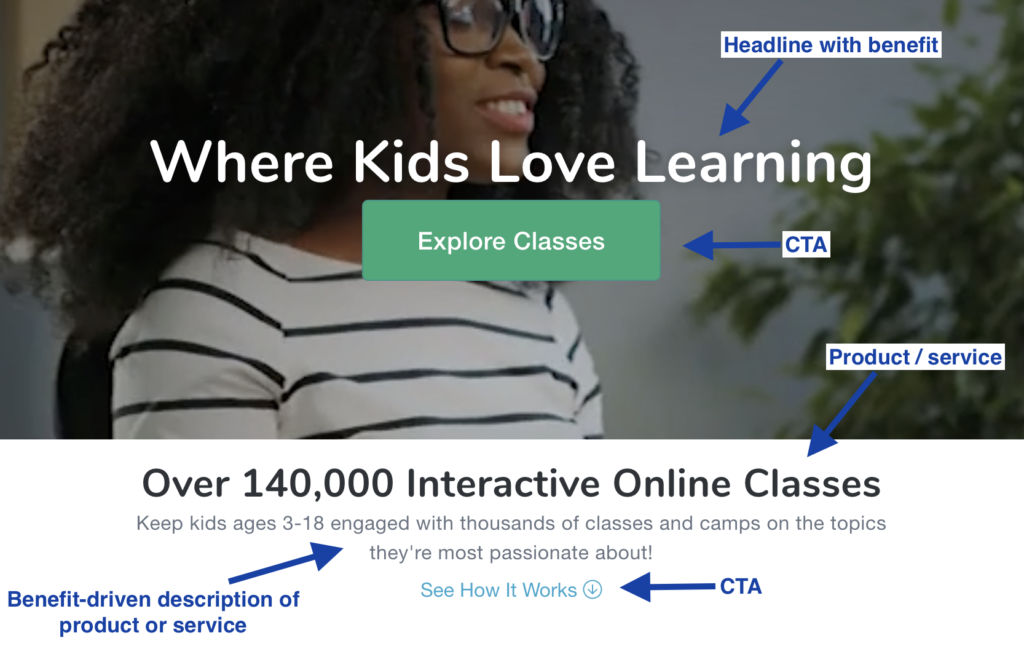An effective website that tells customers who you are, what you do, and how they can purchase your products or services can go a long way towards creating a sustainable and successful business. Even though many educators on Outschool base their business operations on our platform, launching a separate website that directs people to your Outschool classes can help you:
- Stand out from competitors and increase enrollments
- Use SEO and unique content to connect with your target audience
- Better test and evaluate digital marketing campaigns (like social media posts or online ads) with website analytics tools
Platforms like Squarespace and Wix make it simple for anyone to design a professional site without any coding or tech knowledge. Many educators find that publishing a website is crucial to building their brand and amplifying their ability to reach more learners.
Remember that to stay in line with our communication policy, you may use your site to direct people to your Outschool profile or classes (and not the other way around), and you should only communicate with enrolled families using Outschool’s messaging tools.
Ready to tell the world what you teach on your own website? Here are a few pieces of advice to get you started.
Plan your work
If you head to a website building platform like Squarespace, it can be easy to get lost in the thousands of website designs to choose from. Imagine that after plenty of scrolling, you finally find one that you love! But wait – now you’re faced with a blank template and are trying to write headlines and descriptions on the fly. Then you realize you don’t know what to put in the image blocks or which colors to choose… it’s overwhelming, and you decide your website has to wait another day to be born.
So – how do you avoid overwhelm and start strong? Make a plan for what information you want to share on your website and what content you’ll need to create.
First things first: Have you established your brand’s mission, identity, and target audience? If not, start here. Those foundational pieces will help direct the decisions you need to make when designing your website. Once you’ve crafted your brand identity according to the branding guide above, your color scheme, fonts, and images should be relatively easy to transfer onto a website template. This frees you up to focus on content before diving into design.
Decide on pages & content
How many pages will you need on your website, and what content should you include there? Content for your first website will probably include descriptive writing (called “copy” when used to market your business), images, a contact form, and maybe videos. We suggest visiting websites you think look great and taking notes on what you may want to emulate on your own site! Could you even see what other successful educators on Outschool are doing to spark unique ideas for your business?
If you need more inspiration, check out the examples of stellar sites below for inspiration before you get started.
- 55 Beautiful Squarespace Websites
- Best Small Business Websites by Webflow
- Hubspot’s Best Website Designs Catalog
What you decide to add to your website really depends on what you teach and how you want to communicate your class offerings, but here are a few general guidelines that will apply to most teaching businesses:
Home page
Your Home page is the first thing many users will see when they land on your site; this is your chance to grab their attention and keep them scrolling through to see why they should invest in your services. A great home page:
- Clearly describes what you do and who should enroll in your classes
- Allows users to click into other areas of your website from the Home page with buttons or links (known as CTAs or calls-to-action in the marketing world)
- Explains the benefit of what you do for your audience
Take Outschool’s Home page banner as an example:

To view this page in action, you’ll may need to open a private browsing window and then go to outschool.com. Your Home page probably won’t follow exactly this design as you let your personality and brand shine. Still, it’s a good example of how you can showcase your business’s services and benefits to families right away on your website.
After creating a captivating header, use the rest of your Home page to help users find what they’re looking for on your site with short, easy-to-read sections on things like your background, your classes, and why families should choose you to teach their learners.
About me
An “About Me” page is a great place to share more about your background and help families decide to sign up for classes (similar to your Educator Profile on Outschool). Consider including a high-quality photo of yourself and a brief description of your qualifications, teaching style, and goals for your learners. If you’ve established a mission statement and core values for your business, you could include them here, too. Think about adding keywords about your teaching subject and classes to improve your SEO performance and help your site appear in web searches.
The real secret to writing an excellent About Me page is to remember that the page isn’t actually about you – it’s about your audience. This page is your chance to market yourself to your ideal parents and learners by telling them exactly how you’ll meet their needs and why you’re the best at what you do.
Here’s an example of how you can craft your copy to talk about you while really speaking directly to your audience’s experience with your business:
Instead of: I love teaching about plants and gardening, and I have extensive experience as a professional landscaper. I’m trained in using hands-on teaching techniques to make classes interactive and engaging.
Try something like: I use the knowledge I’ve gained over ten years as a professional landscaper to teach children how to start and care for a garden. My hands-on, interactive teaching techniques keep students engaged throughout every lesson and inspire them to find joy in their own backyard.
See how this example is all about the learners’ experience in class, with a few personal details woven in? It can be a tricky balance to achieve, but make it a practice to always think of your audience first when writing copy for your website – it will get easier over time!
Classes you teach
Your website should have a section devoted to promoting your classes and directing visitors to enroll through Outschool. If you teach multiple subjects or a wide variety of topics within one subject area, you may choose to divide content up between a few different pages (this approach can be great for SEO, as well).
Keep in mind that too much text on a page can cause users to skim the copy or, even worse, abandon the page because it’s overwhelming to take in, so keep your writing brief and focused on the benefits to your learners. Your goal is to encourage website visitors to click through to your Outschool class listing, where they can see all the details about every class and actually enroll.
Launching your teaching business website
Share a draft of your website with some trusted family or friends to get feedback and make adjustments before going live. Don’t get paralyzed by the idea that your website needs to be absolutely perfect before you publish; everyone makes improvements and adjustments to their sites over time. If your goal is to have a website for your business, it’s better to have a pretty good site than no site at all.
Once your website is live, you have the opportunity to use data about website traffic, clicks, and more to determine how to better market your business. Google Analytics for Beginners is a good place to start if you’re new to monitoring a website, and we strongly recommend familiarizing yourself with search engine optimization (SEO). To learn more about how other Outschool educators use business websites to boost enrollments, check out this article or try posting in the Educator Hub.

